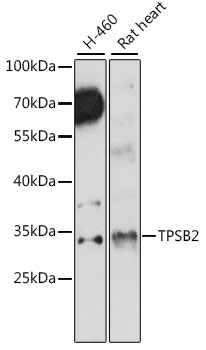Anti-TPSB2 Antibody (CAB15887)
- SKU:
- CAB15887
- Product type:
- Antibody
- Reactivity:
- Human
- Reactivity:
- Rat
- Host Species:
- Rabbit
- Isotype:
- IgG
- Antibody Type:
- Polyclonal Antibody
- Research Area:
- Immunology
Frequently bought together:
Description
| 抗体名: | Anti-TPSB2 Antibody |
| 抗体コード: | CAB15887 |
| 抗体サイズ: | 20uL, 50uL, 100uL |
| 申し込み: | WB |
| 反応性: | Human, Rat |
| 宿主種: | Rabbit |
| 免疫原: | Recombinant fusion protein containing a sequence corresponding to amino acids 1-275 of human TPSB2 (NP_077078.5). |
| 申し込み: | WB |
| 推奨希釈: | WB 1:500 - 1:2000 |
| 反応性: | Human, Rat |
| ポジティブサンプル: | H-460, Rat heart |
| 免疫原: | Recombinant fusion protein containing a sequence corresponding to amino acids 1-275 of human TPSB2 (NP_077078.5). |
| 精製方法: | Affinity purification |
| ストレージバッファ: | Store at -20'C. Avoid freeze / thaw cycles. Buffer: PBS with 0.02% sodium azide, 50% glycerol, pH7.3. |
| アイソタイプ: | IgG |
| 順序: | MLNL LLLA LPVL ASRA YAAP APGQ ALQR VGIV GGQE APRS KWPW QVSL RVRD RYWM HFCG GSLI HPQW VLTA AHCV GPDV KDLA ALRV QLRE QHLY YQDQ LLPV SRII VHPQ FYTA QIGA DIAL LELE EPVN VSSH VHTV TLPP ASET FPPG MPCW VTGW GDVD NDER LPPP FPLK QVKV PIME NHIC DAKY HLGA YTGD DVRI VRDD MLCA GNTR RDSC QGDS GGPL VCKV NGTW LQAG VVSW GEGC AQPN RPGI YTRV TYYL DWIH HYVP KKP |
| 遺伝子ID: | 64499 |
| Uniprot: | P20231 |
| セルラーロケーション: | Secreted |
| 計算された分子量: | 30kDa |
| 観察された分子量: | 30kDa |
| 同義語: | TPSB2, TPS2, tryptaseB, tryptaseC |
| バックグラウンド: | Tryptases comprise a family of trypsin-like serine proteases, the peptidase family S1. Tryptases are enzymatically active only as heparin-stabilized tetramers, and they are resistant to all known endogenous proteinase inhibitors. Several tryptase genes are clustered on chromosome 16p13.3. These genes are characterized by several distinct features. They have a highly conserved 3' UTR and contain tandem repeat sequences at the 5' flank and 3' UTR which are thought to play a role in regulation of the mRNA stability. These genes have an intron immediately upstream of the initiator Met codon, which separates the site of transcription initiation from protein coding sequence. This feature is characteristic of tryptases but is unusual in other genes. The alleles of this gene exhibit an unusual amount of sequence variation, such that the alleles were once thought to represent two separate genes, beta II and beta III. Beta tryptases appear to be the main isoenzymes expressed in mast cells, whereas in basophils, alpha-tryptases predominate. Tryptases have been implicated as mediators in the pathogenesis of asthma and other allergic and inflammatory disorders. |
| UniProt Protein Function: | TPSB2: Tryptase is the major neutral protease present in mast cells and is secreted upon the coupled activation-degranulation response of this cell type. Has an immunoprotective role during bacterial infection. Required to efficiently combat K.pneumoniae infection. Belongs to the peptidase S1 family. Tryptase subfamily. |
| UniProt Protein Details: | Protein type:EC 3.4.21.59; Secreted; Secreted, signal peptide; Protease Chromosomal Location of Human Ortholog: 16p13.3 Cellular Component: extracellular region Molecular Function:protein binding; serine-type peptidase activity; serine-type endopeptidase activity Biological Process: proteolysis |
| NCBI Summary: | Tryptases comprise a family of trypsin-like serine proteases, the peptidase family S1. Tryptases are enzymatically active only as heparin-stabilized tetramers, and they are resistant to all known endogenous proteinase inhibitors. Several tryptase genes are clustered on chromosome 16p13.3. These genes are characterized by several distinct features. They have a highly conserved 3' UTR and contain tandem repeat sequences at the 5' flank and 3' UTR which are thought to play a role in regulation of the mRNA stability. These genes have an intron immediately upstream of the initiator Met codon, which separates the site of transcription initiation from protein coding sequence. This feature is characteristic of tryptases but is unusual in other genes. The alleles of this gene exhibit an unusual amount of sequence variation, such that the alleles were once thought to represent two separate genes, alpha and beta 1. Beta tryptases appear to be the main isoenzymes expressed in mast cells; whereas in basophils, alpha tryptases predominate. Tryptases have been implicated as mediators in the pathogenesis of asthma and other allergic and inflammatory disorders. [provided by RefSeq, Jul 2008] |
| UniProt Code: | P20231 |
| NCBI GenInfo Identifier: | 13775595 |
| NCBI Gene ID: | 7177 |
| NCBI Accession: | NP_003285.2 |
| UniProt Secondary Accession: | P20231,O95827, Q15664, Q9UQI6, Q9UQI7, D2E6S0, D2E6S2 |
| UniProt Related Accession: | Q15661 |
| Molecular Weight: | 30,515 Da |
| NCBI Full Name: | tryptase alpha/beta-1 |
| NCBI Synonym Full Names: | tryptase alpha/beta 1 |
| NCBI Official Symbol: | TPSAB1 |
| NCBI Official Synonym Symbols: | TPS1; TPS2; TPSB1 |
| NCBI Protein Information: | tryptase alpha/beta-1; tryptase I; tryptase-1; tryptase-I; tryptase-III; tryptase beta 1; tryptase beta I; tryptase beta-1; tryptase alpha-1; tryptase alpha II; mast cell beta I tryptase; mast cell alpha II tryptase |
| UniProt Protein Name: | Tryptase beta-2 |
| UniProt Synonym Protein Names: | Tryptase II |
| Protein Family: | Tryptase |
| UniProt Gene Name: | TPSB2 |
| UniProt Entry Name: | TRYB2_HUMAN |


